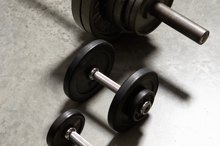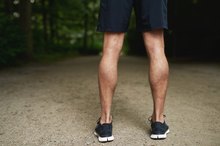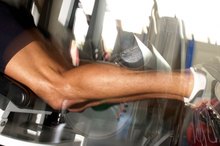Difference Between a Pulled Muscle & a Cramp
Both a pulled muscle and a muscle cramp can stop you in your tracks 1. A pulled muscle is a sustained injury, while a muscle cramp is a typically harmless event that goes away quickly 1. Understanding what causes them as well as how to prevent them can help you reach your fitness goals uninterrupted.
If you are experiencing serious medical symptoms, seek emergency treatment immediately.
Tips
A muscle strain is an injury; a muscle cramp is sudden contraction of the muscle that goes away in minutes.
Leg Cramp vs. Pulled Muscle
Is it a leg cramp or a muscle tear 1? You can usually tell right away, just by the sensations. A muscle cramp is an intense muscle spasm 1. Your muscle seizes up and gets hard and tight 1. The pain can be mild to severe. You may be able to see visible twitching through the skin.
But within minutes, the pain and tightness subside. With a few stretches and light massage, the muscle usually returns to near normal and you can resume your activity, although you might have some residual soreness.
A pulled muscle, on the other hand, is an acute injury. It occurs when the muscle fibers become overstretched, by a little or a lot 2. In a severe strain, the muscle can tear in two or become separated from the ligament that attaches it to bone. The pain is mild to severe, there might be swelling and bruising, and you might feel muscle weakness or a complete loss of muscle function. You might also experience muscle spasms similar to muscle cramps.
Pulled muscles take longer to resolve. They need treatment to reduce the swelling and bruising, and they may even require surgery. Because strains can cause loss of strength and mobility, rehabilitation exercises are part of the recovery program.
- Is it a leg cramp or a muscle tear 1.
- They need treatment to reduce the swelling and bruising, and they may even require surgery.
What Causes Muscle Cramps?
Pain in the Quadriceps
Learn More
Medications can also increase the risk of muscle cramps. Examples include:
- diuretics
- asthma medications
- statins
- as well as medications to treat Parkinson's
- Alzheimer's
- angina
- high blood pressure
- osteoporosis
Causes of Pulled Muscles
- Muscle fatigue/overexertion.
- Weak muscles.
- Working out with cold muscles.
- Having poor flexibility.
- Using improper form while exercising.
:
Treatment for Leg Cramps
Bicep Muscle Strain
Learn More
At the first sign of a muscle cramp, stop whatever you're doing and stretch the affected muscle 1. If the cramp is in your calf muscle, extend your leg and reach down and pull the toes up toward your face 1. Hold the stretch until you feel the cramp begin to dissipate.
You can also massage the muscle gently with your fingers to help it relax. Applying a heating pad to the muscle will also encourage it to relax.
- At the first sign of a muscle cramp, stop whatever you're doing and stretch the affected muscle 1.
- Applying a heating pad to the muscle will also encourage it to relax.
Prevent Muscle Cramps
Not all muscle cramps can be avoided; however, taking several steps can help reduce the risk:
- Fix mineral deficiencies. If your doctor determines you are deficient in potassium, magnesium or calcium, he will instruct you to make dietary changes or take a supplement.
- Stay hydrated. Drink plenty of water before, during and after physical activity, especially if you are exercising or working outside in hot weather. * Avoid sitting too long. If you are working at a desk or on a long flight, get up and walk around every so often. * Stretch. Before performing any exercise or other strenuous activity, stretch the muscles you will be using. Then stretch those muscles again afterward.
If you experience nocturnal leg cramps, stretching and/or doing some light cardio, such as riding an exercise bike, before bed may prevent them.
- Not all muscle cramps can be avoided; however, taking several steps can help reduce the risk: * Fix mineral deficiencies.
- & nbsp;If your doctor determines you are deficient in potassium, magnesium or calcium, he will instruct you to make dietary changes or take a supplement. * Stay hydrated.
- &
Treatment for Muscle Strains
Pulled muscle treatment depends on the severity of the injury. Mild strains can be treated at home with the RICE method, which includes:
- Rest. Avoid activity that stresses the strained muscle. * Ice. Apply an ice pack for 10 to 20 minutes at a time on the hour or as often as possible. * Compression. Wrap the muscle in an elastic bandage snugly, but not too tight.
- Elevation. Raise the injured muscle above or at the level of the heart.
The goal of RICE is to reduce swelling, blood pooling and pain. It's most effective if started immediately after the injury occurs and continued for at least 48 hours.
More serious pulls may require a visit to your doctor. If the pain is severe or long lasting and/or there is a lot of swelling and muscle weakness that affects your ability to move around, call your doctor. He will run some tests to assess the extent of the damage and determine whether your injury needs further medical treatment, immobilization, surgery or another type of treatment.
- Pulled muscle treatment depends on the severity of the injury.
- Compression. Wrap the muscle in an elastic bandage snugly, but not too tight. * Elevation. Raise the injured muscle above or at the level of the heart. The goal of RICE is to reduce swelling, blood pooling and pain.
Prevent Pulled Muscles
- Strengthen weak muscle groups.
- Increase the intensity of your exercise program gradually.
- Avoid awkward or sudden movements.
- Use proper lifting technique.
- Practice good posture.
:
Related Articles
References
- Mayo Clinic: Muscle cramp
- Harvard Health Publishing: Muscle Strain
- WebMD: Why Is My Leg Cramping? What Can Help?
- American Osteopathic Association: Coping with muscle cramps: Why you don’t have to live with this common pain
- Healthline: Muscle Strains
- Young G. Leg cramps. BMJ Clin Evid. 2015;2015
- Jahic D, Begic E. Exercise-associated muscle cramp-doubts about the cause. Mater Sociomed. 2018;30(1):67-69. doi:10.5455/msm.2018.30.67-69
- Waters TR, Dick RB. Evidence of health risks associated with prolonged standing at work and intervention effectiveness. Rehabil Nurs. 2015;40(3):148-65. doi:10.1002/rnj.166
- Skogar O, Lokk J. Pain management in patients with Parkinson's disease: challenges and solutions. J Multidiscip Healthc. 2016;9:469-479. doi:10.2147/JMDH.S105857
- Hallegraeff J, De greef M, Krijnen W, Van der schans C. Criteria in diagnosing nocturnal leg cramps: a systematic review. BMC Fam Pract. 2017;18(1):29. doi: 10.1186/s12875-017-0600-x
- Mcdermott MM. Lower extremity manifestations of peripheral artery disease: the pathophysiologic and functional implications of leg ischemia. Circ Res. 2015;116(9):1540-50. doi:10.1161/CIRCRESAHA.114.303517
- Blyton F, Chuter V, Walter KE, Burns J. Non-drug Therapies For Lower Limb Muscle Cramps. Cochrane Database Syst Rev 2012; 1:CD008496.
- Grandner MA, Winkelman JW. Nocturnal leg cramps: Prevalence And Associations With Demographics, Sleep Disturbance Symptoms, Medical Conditions, And Cardiometabolic Risk Factors. PLoS One 2017; 12:e0178465.
- Allen RE, Kirby KA. Nocturnal Leg Cramps. Am Fam Physician 2012; 86:350
- American Academy of Sleep Medicine. Sleep Related Leg Cramps. In: International Classification of Sleep Disorders, 3rd ed., American Academy of Sleep Medicine, Darien, IL 2014. p.299-303.
- Maquirriain J, Merello M. The Athlete with Muscular Cramps: Clinical Approach. J Am Acad Orthop Surg 2007; 15:425.
Writer Bio
Jody Braverman is a professional writer and editor based in Atlanta. She studied creative writing at the American University of Paris and received a Bachelor of Arts in English from the University of Maryland. She also received personal trainer certification from NASM and her 200-hour yoga teacher certification from YogaWorks.








